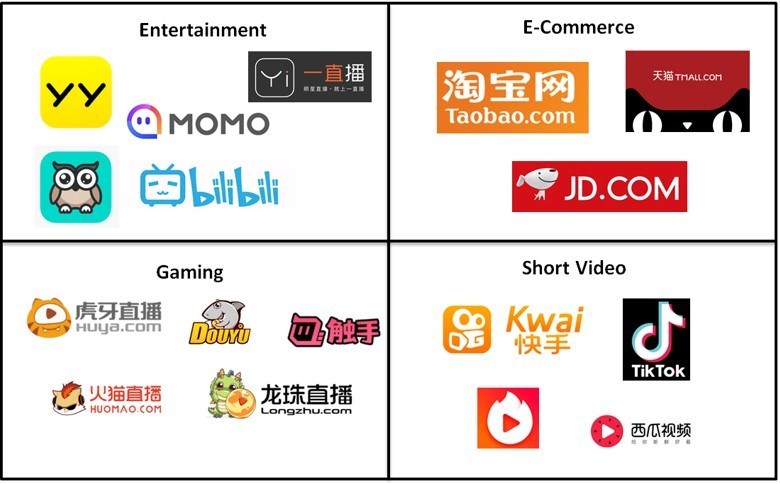With both the increase in gamer numbers and demand for quality content, the rise of e-sports in China has led to a boom in game streaming services.
When we think about livestreaming in the West, we mainly think of it as a recent trend introduced by companies such as Justin.tv and Twitch. However, countries in the East have been experimenting with livestreaming since early 2006, with companies such as YY in China being early movers. Today, the livestreaming industry in China continues to be significantly larger than the US in terms of users, demographics, and innovation, especially when it comes to product design and monetization methods.
The Chinese livestreaming industry experienced a period of boom and bust in 2016–2017. During this time, over 200 mobile apps with livestreaming features emerged. However, after government restrictions and a washout on a large number of platforms, the industry consolidated significantly. Today, only a few leaders in each vertical remain.
Out of all verticals, I am most optimistic about the gaming category because of the growth of e-sports. Compared to entertainment streaming, video game streaming is much more mass market, with limited revenue concentration among top customers. Additionally, its audience is more engaged and demonstrates a higher stickiness to the content itself.
Why video game streaming?
Simply put, China has the largest gaming population in the world with over 630 million participants. Even with the recent regulations on new gaming licenses in 2018, China remains the largest gaming market globally, bringing in revenues of ~$30 billion annually, according to Newzoo. The industry is expected to grow at a 10% CAGR over the next five years. E-sports are a global phenomenon and an even stronger secular trend in China. In 2016, China’s National Development and Reform Commission even encouraged the development of e-sports tournaments on the premise of protecting intellectual property. With both the increase in gamer numbers and demand for quality content, the rise of e-sports in China has led to a boom in game streaming services.
A few reasons to expect steady growth:
- Growing TAM and sticky user base: It is estimated that in China there will be over 450 million e-sport gamers by 2021 compared with 350 million last year. As opposed to entertainment livestreaming, those who watch game livestreams are more engaged—nearly one-third of users watch on a daily or monthly basis. Additionally, game streaming platforms enjoy a higher average revenue per paying user (ARPPU) than non-game streaming platforms (non-gaming ARPPU peaked in 2018). This is likely because gaming is more relatable and participants enjoy watching others to improve their own skills.
- Rapid market consolidation: It is apparent that the biggest barrier to entry and threat to new and existing streaming platforms is the ability to preserve talent. Huya and Douyu have over 60% market share because of their brand presence and large capital base, allowing them to recruit the best streamers and organize the largest e-sports events. There is some brand equity associated with these platforms. Similar to a two-sided marketplace, users and broadcasters often gravitate towards platforms with the most content and the best well-known streamers.
- game streaming platforms = Monetizable opportunity in the e-sports value chain: The e-sports industry is still in the early innings of its growth cycle. Excluding games sold, streaming revenue makes up more than three-quarters of the e-sports industry earnings. In the future, revenue opportunities will arise through media rights, ticketing, and merchandising. Livestreaming platform investors can partake in the current growth opportunities and take advantage of the optionality of future media rights from e-sports events.
Major players—past, present, and future
Similar to China’s broader livestreaming industry, the game livestreaming market experienced a period of boom and bust in 2016–2017, as smaller platforms lost both broadcasters and users. The largest casualty came in March 2019 when Panda.TV, backed by the son of Dalian Wanda Chairman Wang Jianlin, shut down after running out of cash.
Today, the two leading pureplay game streaming platforms are Huya and Douyu. Both companies went public in the past year. As the largest gaming company in China, Tencent has a stake in the livestreaming market, owning over 30% of both Huya and Douyu. Despite the stiff competition, there are still some second-tier platforms in this space, namely Longzhu and Huomao. Some of these smaller players are likely to either be acquired or eventually run out of cash as more users migrate to the largest platforms.
Looking ahead, some short-form video platforms are attempting to break into the livestreaming space with a particular focus on gaming. One possible threat is Kuaishou, which boasts over 300 million MAUs. Earlier in 2019, Kuaishou launched an independent streaming app called Diaomiao.
In my next piece, I will take a deeper dive on Huya and Douyu to break down what to look for when investing in a public company this space. Also, I will explore a bit more on the emerging competitors that could disrupt the two leading platforms.
– This article originally appeared on TechNode.








